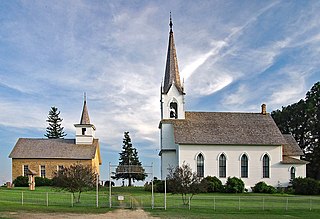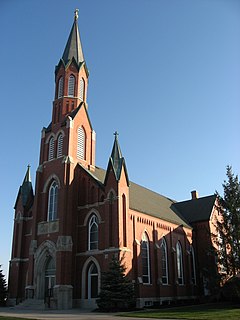
Christ Church Cathedral, built in 1916 to replace the earlier 1874 building, is the Episcopal cathedral in Eau Claire, Wisconsin. It is the mother church for the Episcopal Diocese of Eau Claire, the see of which is located in Eau Claire. The cathedral and parish house were added to the National Register of Historical Places in 1982.

Our Lady of Lourdes Catholic Church is a Roman Catholic parish church of the Archdiocese of Saint Paul and Minneapolis located in Minneapolis, Minnesota in the United States. It was built on the east bank of the Mississippi River in today's Nicollet Island/East Bank neighborhood; it is the oldest continuously used church building in the city and is part of the St. Anthony Falls Historic District.

Clarence Howard Johnston Sr. was an American architect who practiced in the US state of Minnesota during the late 1800s and early 1900s. Specializing in domestic, religious, and public architecture, he served as Minnesota State Architect from 1901 to 1931. He is considered one of the most prolific architects in the state's history.

The Church of the Assumption Catholic Church was dedicated in 1874 and is the oldest existing church in Saint Paul in the state of Minnesota (U.S.). It is located at 51 West Seventh Street, in downtown Saint Paul. The building is listed on the National Register of Historic Places.

Valley Grove is a historic Lutheran church complex in Wheeling Township, Minnesota, United States. It consists of two 19th-century churches surrounded by a hilltop cemetery. The older building was constructed in stone in 1862 by a rural community of Norwegian immigrants. The congregation outgrew the first church and constructed a larger, wooden replacement in 1894, converting the original building into a guild hall. The property was listed on the National Register of Historic Places in 1982 for its local significance in the themes of architecture, art, and religion. It was nominated for encapsulating two phases of rural ecclesiastical architecture in a dramatic hilltop tableau, and for its role in anchoring eastern Rice County's dispersed community of Norwegian immigrants.

The Church of Saint Agnes is an onion-domed Catholic church designed by George Ries, built 1901–1912 for the German-speaking Austro-Hungarian population of immigrants in Saint Paul, Minnesota, United States. It is listed on the National Register of Historic Places.

The Church of St. Wenceslaus is a Catholic church in New Prague, Minnesota, United States, constructed in 1907. The church is flanked by a 1908 rectory and a 1914 parochial school, and the three-building complex is listed on the National Register of Historic Places for its association with the Czech American settlement of south-central Minnesota.

St. Josaphat Roman Catholic Church is a Roman Catholic church located at 715 East Canfield Street in Detroit, Michigan. It was listed on the National Register of Historic Places in 1982 and designated a Michigan State Historic Site in 1985. Since 2013, it has been one of two churches that comprise Mother of Divine Mercy Parish.

St. Sebastian's Catholic Church is a historic Roman Catholic church in Marion Township, Mercer County, Ohio, United States. Located in the unincorporated community of Sebastian, it is the home of an active congregation and has been declared a historic site because of its well-preserved early twentieth-century Gothic Revival architecture.

St. Aloysius Catholic Church is a historic Roman Catholic church in Carthagena, an unincorporated community in Marion Township, Mercer County, Ohio, United States. Built in the late nineteenth century, it remains the home of an active parish, and it has been designated a historic site because of its well-preserved architecture.

St. Stephen's Episcopal Church is an historic Carpenter Gothic style Episcopal Church church building located in Newton, Iowa, United States. Completed in 1881, it was built by the contractor David S. Strover and master carpenter Joe Stevens. On September 22, 1977, it was listed on the National Register of Historic Places. It serves a parish church in the Episcopal Diocese of Iowa.

St. Rose's Catholic Church is a historic Catholic church in St. Rose, an unincorporated community in Marion Township, Mercer County, Ohio, United States.

Immaculate Conception Catholic Church is a parish of the Roman Catholic Church in Celina, Ohio, United States. Founded later than many other Catholic parishes in the heavily Catholic region of western Ohio, it owns a complex of buildings constructed in the early 20th century that have been designated historic sites because of their architecture. Leading among them is its massive church, built in the Romanesque Revival style just 43 years after the first Catholic moved into the city: it has been called northwestern Ohio's grandest church building.

St. Peter's Episcopal Church is a large historic Carpenter Gothic Episcopal church building located at the corner of Division and Telegraph streets in Carson City, Nevada. Built in 1868, it is the oldest Episcopal church still in use in Nevada. On January 3, 1978, it was listed on the National Register of Historic Places.

The Church of the Sacred Heart is a historic Roman Catholic church building in Freeport, Minnesota, United States. The church was constructed from 1905 to 1906 as the third and largest building to house a congregation formed by the community's German American settlers in 1881. The property was listed on the National Register of Historic Places in 1991 as Church of the Sacred Heart (Catholic) for its local significance in the theme of social history. It was nominated for demonstrating the central role played by the Catholic church in Freeport and many other Central Minnesota communities settled by German immigrants.

The Church of the Holy Trinity is a Roman Catholic church in Rollingstone, Minnesota, United States, built in 1869 and expanded in 1893. It was listed on the National Register of Historic Places in 1984 for having local significance in the themes of architecture and exploration/settlement. It was nominated for its Gothic Revival architecture and central role in the religious, social, and—through its associated parochial school—academic life in a Luxembourg American community.

The Church of St. Joseph is a historic Roman Catholic church building in St. Joseph, Minnesota, United States. It is part of the Roman Catholic Diocese of Saint Cloud. It was constructed in a German immigrant community in 1869, though the tower wasn't completed until 1884. A rectory stands east of the church. Both buildings were listed on the National Register of Historic Places in 1982 for their state-level significance in the themes of architecture, exploration/settlement, and religion. The property was nominated for reflecting the settlement of rural Stearns County by Catholic immigrant groups clustered in small, ethnic hamlets dominated by a central church.

The Church of St. Bridget is a Roman Catholic church in De Graff, Minnesota, United States. The parish, founded in 1876, was the first established in a major drive by Archbishop John Ireland to settle western Minnesota with Catholics. Its current building was constructed in 1901 and was listed on the National Register of Historic Places in 1985 for having local significance in the themes of architecture, community planning and development, exploration/settlement, and religion. It was nominated for its association with the beginning of Archbishop Ireland's colonization effort, the influence of the Catholic church on De Graff's development and population, and for being a rare outstate church building designed by Saint Paul architect Edward J. Donahue.

The historic Church of St. Joseph is a church in Browerville, Minnesota, United States. It was built from 1908 to 1909 by a community of Polish immigrants that had established itself in the area from 1870 to 1900. The building was listed on the National Register of Historic Places as Church of St. Joseph--Catholic in 1985 for its local significance in the themes of architecture, exploration/settlement, and religion. It was nominated for its unifying central role in an immigrant community.

Holy Guardian Angels Church and Cemetery Historic District is a nationally recognized historic district located in Roselle, Iowa, United States. Holy Guardian Angels is a former Catholic parish of the Diocese of Sioux City. The historic district made up of the former parish church and cemetery was listed on the National Register of Historic Places in 2019. It is significant for the architecture of the Gothic Revival church and the influence of the German-Catholic immigrants who settled the area.























